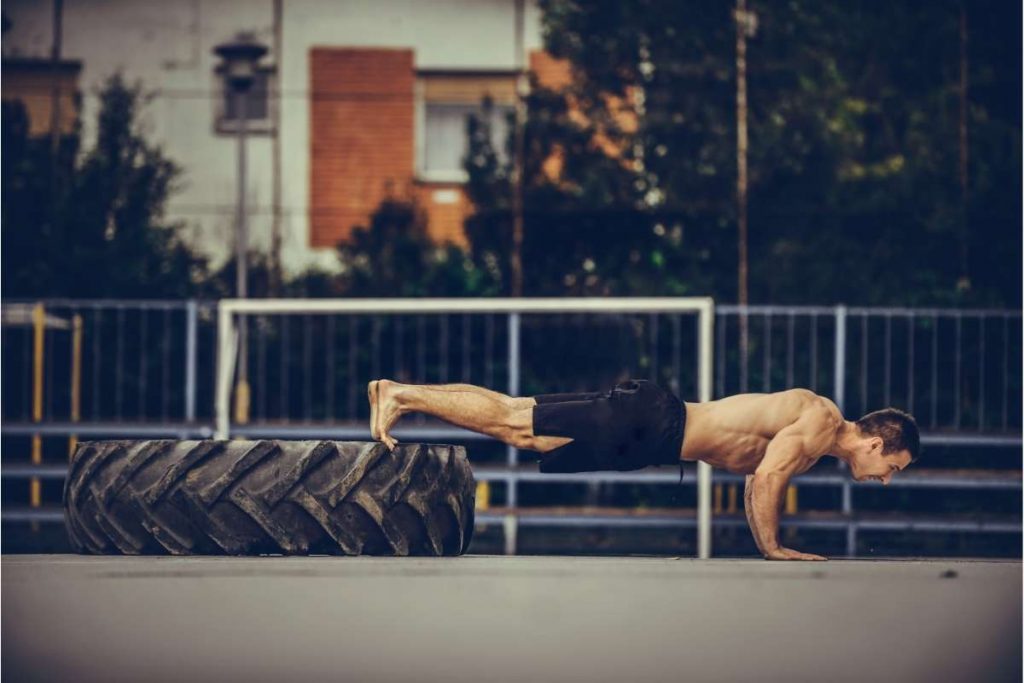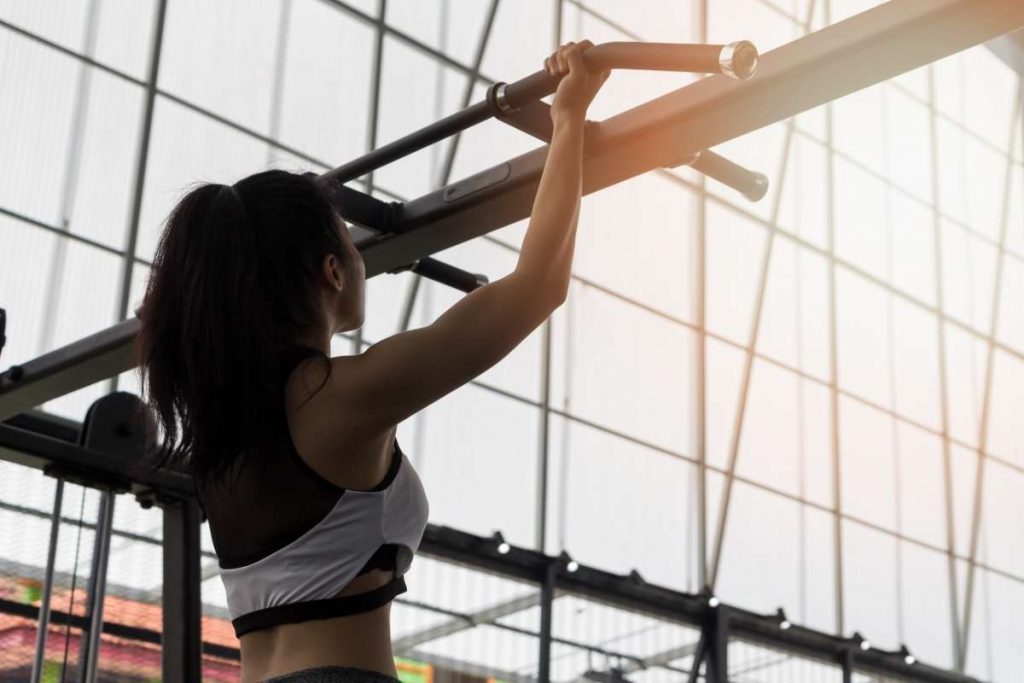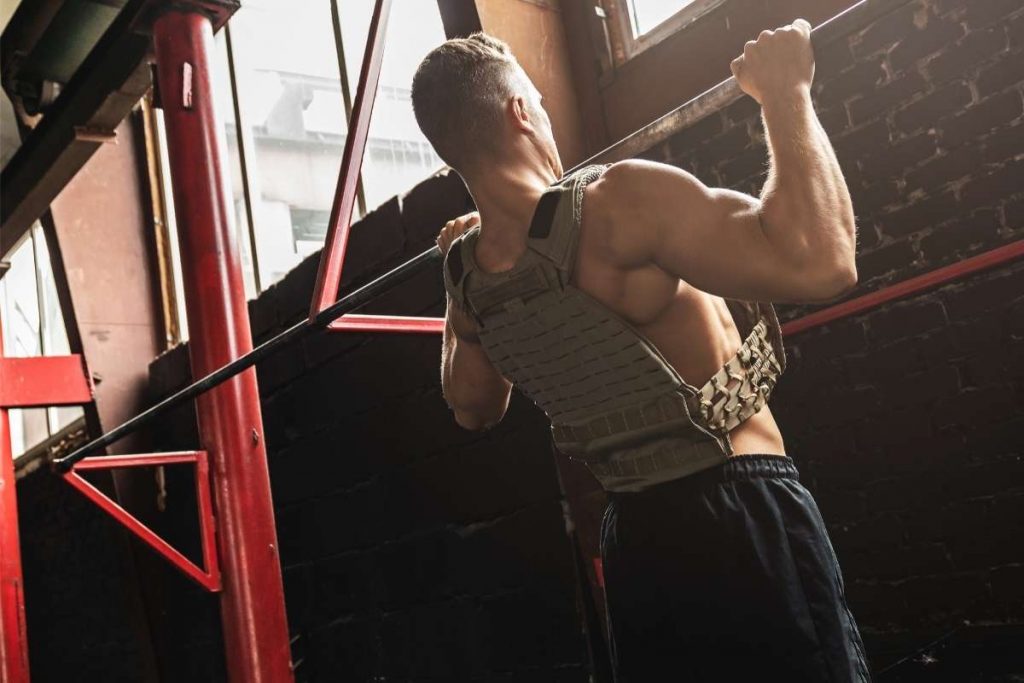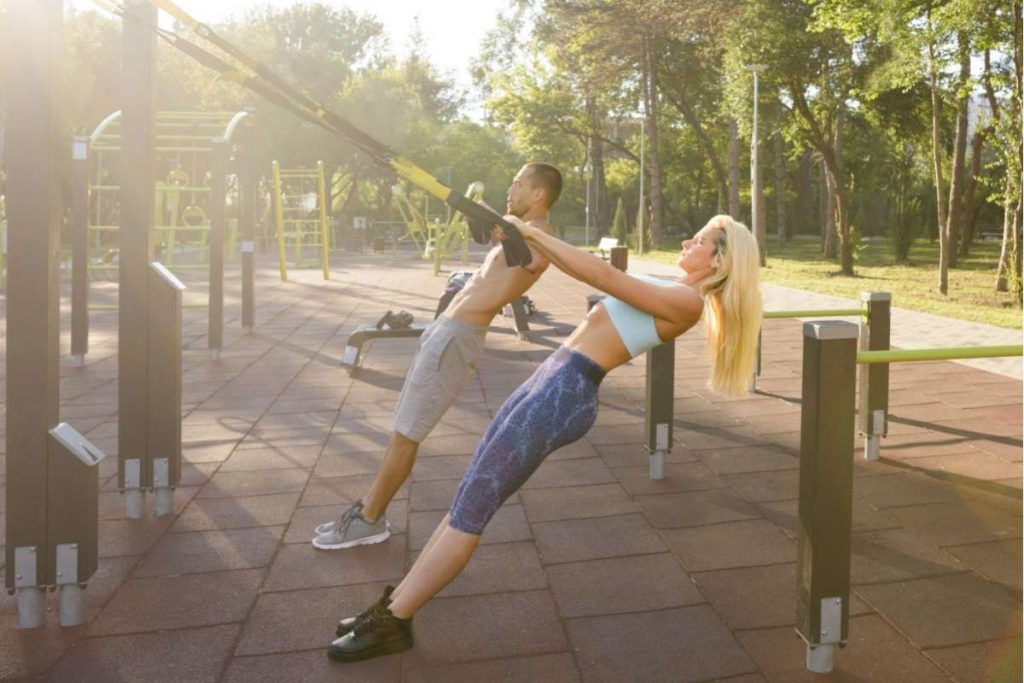What's inside
Have you ever watched in amazement as gymnasts effortlessly command their bodies? They appear weightless as they seamlessly transition from handstands to L-sits.
Such amazing feats of strength and control inspire many of us to implement calisthenics into our routines.
This often falls flat when we discover how difficult the task is. You might end up limiting your programming to just a few sets of push-ups and pull-ups.
The key to breaking through is shoulder strength conditioning.
Today, I’m going to share the 12 best calisthenic shoulder exercises to add variety to your training.
Are you ready to prepare your body and break through the barriers of your calisthenics training journey?
Let’s dive in.
Why You Should Include Calisthenic Shoulder Workouts Into Your Training Routine
Calisthenics shoulder workouts are a great way to improve shoulder strength and health that you will benefit from for a lifetime.
Best of all, these are bodyweight exercises, so we can train without equipment.
This allows us to stick to our programming. There are no excuses; you can develop strong, functional shoulders even when you’re away from the gym.
Main Benefits of Calisthenic Shoulder Exercises

Let’s talk about the benefits of calisthenics shoulder exercises and why you should consider implementing them into your training.
Engages Multiple Muscle Groups
The beauty of implementing a calisthenics shoulders workout is that it requires engagement from all of the muscles of your entire body.
Many of the movements that you will perform for your shoulder require a degree of engagement from your back, core, and hips to stabilize.
This is due to the variety of positions that you may need to assume to create resistance through gravity.
Exercises such as pikes and handstand push-ups require us to invert ourselves to create resistance.
Increase Strength
Calisthenics has been noted as a great way to increase strength.
Research illustrates that performing calisthenics can positively increase the 1RM bench press.
Plus, they can be implemented in training gaps and add variety to training to further challenge your body.
Improves Posture
Calisthenics has been shown to improve posture. This is due to the full-body engagement required throughout the movements.
A good example is the humble push-up and other exercises that are great for shoulder function.
Through the movement, the areas of the hips, abdomen, and back must engage for stability.
While this is happening, the thoracic spine (upper back) is subject to a degree of motion while the shoulder blades move with each rep.
This combination of core stability and mobility from the upper body improves the body’s posture while under stress.
No Major Equipment Required
One of the major benefits of using calisthenics shoulder exercises is that they can be done anywhere.
It’s helpful for reducing the costs of expensive gym memberships and saving on home gym equipment. Overall, it’s a fast, reliable fix for those who can’t train due to lack of equipment.
This leads to a potential increase in physical activity which has been identified to improve overall health.
Want to know how one of the fittest men on earth uses calisthenics to stay fit? Check out David Goggins Workout Routine and Diet Plan
Drawbacks of Calisthenic Shoulder Exercises

Calisthenic exercise is not without its drawbacks.
Below, I’ve made a list of cons to consider before undertaking this style of training.
Challenging Movements
As calisthenics is made up of bodyweight-style exercises, it can present an issue for those who are novices in the gym or have difficulty pushing their own weight.
While there are ways around this, the immediate barrier of bodyweight training may deter new users.
This is especially true when you have much more ergonomic and accommodating options at the gym.
Variety
Calisthenics can pose an issue of variety to many users, as variation and progressions aren’t always obvious to beginners.
While there are plenty of different movements to perform, some lifters may not like the idea of having to be creative or think of alternatives.
Again, this leads them to seek the comfort of familiar machinery and equipment.
Limited Resistance
There can be limitations to the weight that can be pushed for some exercises.
This may not be an issue for those who are committing to a full calisthenics routine.
However, for those who wish to undertake just a sample of the exercises for shoulders, you may find that the resistance lacks the same grunt of their current weight training-based workout.
The exception would be if you’re loading your shoulders with your full body weight.
Difficulty
What makes calisthenics excellent is its ability to utilize the entire body for each movement.
However, this is also what makes it difficult.
While this can be an incredible way to train, there are many that will find this does not suit their desire to just push and pull heavy weight.
The full-body involvement also puts a challenge on the body that is not found in many other types of training.
This presents a steep learning curve, deterring practitioners.
12 Best Calisthenic Shoulder Exercises

Now that we have addressed the pros and cons, it’s time to share with you the 12 best calisthenics shoulder exercises.
1. YTW
The YTW is a great entry exercise to calisthenics and one that will serve you and your shoulder health.
This movement is excellent for building strong muscles of the rotator cuff and upper back in a safe lying position.
Equipment Required
- Floor space
How To Perform YTW
- Lie face-down on the floor and place hands overhead, palms facing down.
- To begin, use shoulder blades to lift hands off the floor to form a ‘Y’ shape.
- With hands off the floor, move your hands to the side to form a ‘T’ shape.
- Then bring elbows to the sides to form a ‘W’ shape.
- Return hands to the ‘Y’ shape. Repeat.
Benefits
- Great for beginners
- Safe movement
- Can be performed anywhere
- Can improve spinal mobility and reduce pain
Pro Tips
- For beginners, if you find it difficult to hold your arms off the floor for the entire movement, start by placing arms in each position and lifting. This will help you get used to the movement and build up your strength.
- For each position (T, W, Y) hold for one second. This is good for building endurance and allows you to focus on the contraction.
2. Push-Up Plus
A variation of the standard push-up, the push-up plus is a fantastic exercise.
It’s used to strengthen the serratus anterior while building awareness around the concept of hollowing out, which is used regularly in calisthenics.
Equipment Required
- Floor space
How To Perform Push-Up Plus
- To begin, set yourself up in the push position, on your toes with feet shoulder-width apart, hands a chest line, just wider than shoulders.
- With elbows slightly tucked to the side, lower chest toward the floor.
- Once you reach 90 degrees bent at the elbows, push up to the starting position.
- At the top, continue to push, aiming to separate your shoulder blades and pushing the rib cage toward the ceiling.
- Lower to the starting position. Repeat.
Benefits
- Excellent push-up variation
- Increased shoulder awareness as it takes the shoulder blades and shoulder to end range of motion
- Increase strength with low risk of injury
- Targets serratus anterior
Pro Tips
- For beginners who cannot lift their own weight, perform the movement on your knees or against the wall. Here you can focus on the movement and push through to work your serratus.
- At the top of each repetition, focus on pausing and feeling the contraction. This will further establish mind-muscle connection and contraction of the serratus anterior.
3. Dips
One of the greatest bodyweight shoulder exercises, the dips are an essential part of any calisthenic workout.
Equipment Required
- Bench
- Dip Bars
How To Perform Dips
- Standing between a set of dip bars with arms straight, grasp the dips using a neutral grip.
- Slightly lean forward and with elbows tucked, bend elbows and lower yourself down until you reach 90 degrees.
- From here, push up and return to the starting position.
Benefits
- Works the shoulders, chest, triceps, and core
- Great exercise to build strength, which is essential for progression in calisthenic shoulder workouts
Pro Tips
- Beginners can perform the same movement using a chair or bench.
- Beginners should also lower gradually, and aim for 45 degrees to test. This will make it easier to push back up until they are comfortable going lower.
4. Pike Push-Up
The pike push-up allows you to use gravity to target the same muscle as an overhead press.
These exercises also provide us with a solid foundation for more advanced movements such as handstand push-ups.
Equipment Required
- Floor space
How To Perform Pike Push-Up
- From the upright position, bend forward at the hips and place hands on the ground.
- Position hands a foot length away from your feet.
- Tuck your chin down, looking toward your feet.
- To begin the movement, lower head toward the floor by bending the elbows, keeping them tucked toward the midline of the body.
- Lower until elbows bend to 90 degrees, or just until the head reaches the floor.
- To return, push up until you reach the starting position. Repeat.
Benefits
- Targets shoulder and triceps
- Great foundation for building awareness for handstand push-ups
Pro Tips
- If you struggle with flexibility, you can perform the movement with your hands on a bench or a platform. This will reduce the weight going through the upper body and the stretch on the hamstrings.
- When performing the movement, focus on leaning forward as you lower yourself. This will help you keep a comfortable angle at the elbow and shoulder, making for a better overall movement.
5. Shoulder Taps
A simple and effective way to develop shoulder stability, shoulder taps require the entire body.
This is a fantastic way to build functional strength which is vital for calisthenic shoulder workouts and your daily living activities.
Equipment Required
- Floor space
How To Perform Shoulder Taps
- Set yourself up in the push-up position with feet shoulder-width apart and hand below shoulders with arms straight.
- To begin, take a deep breath, engage your core, and lift one hand to tap the opposite shoulder.
- Return your hand to the floor and repeat with the opposite hand.
Benefits
- Improves shoulder stability
- Full-body exercise
Pro Tips
- Beginners can use a bench or the wall. This will help reduce body weight and allow you to focus on technique.
- If you’re having trouble balancing, place feet wide apart for extra balance.
6. Side Plank Twists
The plank twist combines both core and shoulder stability into one exercise.
Equipment Required
- Floor Space
How To Perform Side Plank Twists
- To begin, position yourself on your side with one hand placed on the floor, feet together.
- With the opposite hand, raise it out to the side and into the air.
- To begin the movement, bring your top hand down underneath your body and twist the torso.
- Once your hand reaches just behind your body, twist back up and return your arm to the upright position.
- Perform for both sides.
Benefits
- Great for building core strength
- Builds shoulder stability for the supporting arm
Pro Tips
- Beginners can perform the movement on a bench or on their knees. This will help with balance and reduce weight through the shoulder.
- Keep eyes locked on the moving hand through the movement. This will help balance and allow your body to rotate fully in the full range of motion.
7. Pseudo Planche Push-Up
A true progression into the more advanced movements, the planche push-up works the shoulders in a way that requires a great deal of tension through the entire body.
Equipment Required
- Floor Space
How To Perform Pseudo Planche Push-Up
- Near a wall, assume the push-up position, with the top of the head facing toward the wall.
- Keep weight on toes and hands positioned at the chest line just wider than shoulders, pushing through the shoulders, making a hollow body shape.
- Lean forward toward the wall with your head gently making contact.
- To begin the movement, bend elbows and lower toward the floor.
- When you reach 90 degrees at the elbow, push up and return to the starting position. Repeat.
Benefits
- Full-body exercise
- Great exercise to build a foundation for more advanced calisthenics movements
Pro Tips
- For beginners, start with a smaller lean. This will reduce demand on the shoulders.
- During the course of the movement, focus on maintaining the hollow position and not arching the lower back. This will help you maintain tension through the body for the entire lift and improve performance.
8. Inverted Row
The inverted row is a great entry-level exercise that is an effective way to target the rear shoulder while being scalable to experience levels.
Equipment Required
- Bar
- Squat Rack
- TRX (Suspension Trainer)
How To Perform Inverted Row
- Set up a bar barbell on a squat rack just below chest height.
- Standing on the inside of the rack, grasp the bar just outside shoulder-width.
- Walk legs out underneath until the body is straight and the chest is at the bar line.
- Arms should be straight, with the weight resting in heels.
- To begin, pull the chest toward the bar until it makes contact.
- Squeeze shoulder blades together, lower. Repeat.
Benefits
- Full-body exercise
- Build upper back and rear delts
Pro Tips
- To reduce resistance, beginners can start in a more upright position.
- For each repetition, focus on pulling shoulder blades together. This will ensure you hit the muscles of the upper back and not just your arms.
9. Bodyweight Rear Delt Row
This movement supplements your rear delt training safely and effectively.
Equipment Required
- Wall
How To Perform Bodyweight Rear Delt Row
- Standing with your back against the wall, arms in a ‘T’ shape, out to the side, with the elbows straight.
- Walk your feet about a foot’s length away from the wall so that your upper body is leaning on the wall.
- To begin, squeeze shoulder blades together and push arms into the wall.
- Pause for a second, then lower back to the wall. Repeat.
Benefits
- Great for building the rear deltoid and upper back
- Safe and comfortable position makes it accessible to all experience levels
Pro Tips
- For beginners, start with feet closer to the wall. This will decrease the resistance and allow you to focus on the technique.
- When performing the movement, focus on squeezing shoulder blades together and driving elbows into the wall. This will ensure you hit the muscles of the upper back.
10. Walk Outs
The walk-out is a simple exercise that incorporates shoulder stability and mobility exercises in relation to the entire body.
The walking out process requires the muscles of the upper and lower body to simultaneously engage and lengthen.
Equipment Required
- Floor space
How To Perform Walk-Outs
- From the standing position, bend forward at the hips and place hands on the floor.
- Walk your hands forward until your body is parallel with the floor.
- Walk hands back toward feet and stand back up to the upright position. Repeat.
Benefits
- Full-body engagement
- Improve shoulder stability
Pro Tips
- Beginners may use a box for their hands. This will make it easier if you have limited flexibility in the hamstrings.
- Focus on breaking and engaging core muscles through the duration of the movement. Inhale as you walk out, and exhale as you walk back to the upright position.
11. Hindu Push-Up
The Hindu push-up takes elements of the traditional push-up and adds the challenge to mobility and flexibility with its scooping motion.
Equipment Required
- Floor space
How To Perform Hindu Push-Up
- To begin, place hands and feet on the floor, angling hips into the air.
- Lower your head toward the floor, scooping at the bottom.
- Push up and raise your head to the ceiling.
- Once the movement is completed, push yourself back to the starting position. Repeat.
Benefits
- Excellent bodyweight shoulder exercise
- Great for building shoulder strength
Pro Tips
- Beginners should focus on technique as this movement is challenging and unfamiliar.
- When performing the movement, exhale as you lower and push through, and inhale when you return to the starting position.
12. Wall Walks
Wall walks allow us to practice inverting ourselves, which can be great for building toward handstands and handstand push-ups.
Equipment Required Wall Walks
- Floor space
- Wall space
How To Perform
- Begin in a push-up position with your feet against the wall.
- Walk your feet up the wall while walking your hands toward the wall.
- Walk until your body is flat to the wall.
- From here walk back down to the starting position. Repeat.
Benefits
- Full-body exercise
- Great for building shoulder strength and stability
Pro Tips
- To reduce the difficulty, beginners can walk halfway up the wall and down again. This will reduce resistance and load through the shoulders
- Focus on breathing through the entire movement, while keeping the core engaged. This will help distribute the resistance through the entire body.
Calisthenic Shoulder Workout Program
Related: Chest And Shoulder Workout
Below are my calisthenics shoulder workouts for both beginner and advanced levels, complete with weekly schedules.
Beginner Weekly Schedule
Starting out with shoulder calisthenics can be demanding on the entire body.
This is why there is a break programmed between each session for sufficient rest.
| Mon | Tues | Wed | Thurs | Fri | Sat | Sun |
| Train | Rest | Train | Rest | Train | Rest | Rest |
Beginner Shoulder Workout
| Exercise | Sets | Repetitions | Rest Time |
| YTW | 2 | 5 | 45 – 60 secs |
| Shoulder Taps | 3 | 20 | 45 – 60 secs |
| Push Up Plus | 3 | 10 | 60 secs |
| Bodyweight Rear Deltoid | 3 | 8-10 | 45 secs |
| Inverted Rows | 3 | 8-10 | 60 secs |
| Walk-Outs | 3 | 8-10 | 60 secs |
Advanced Workout Weekly Schedule
For advanced training, a rest day is programmed between each training day.
This program can be done four days per week, continuing to alternating days the following week.
| Mon | Tues | Wed | Thurs | Fri | Sat | Sun |
| Train | Rest | Train | Rest | Train | Rest | Train |
Advanced Shoulder Workout
| Exercise | Sets | Repetitions | Rest Time |
| YTW | 2 | 30 – 60 sec | 45 – 60 secs |
| Walk-Outs | 2 | 10 | 45 – 60 secs |
| Shoulder Taps | 2 | 16 | 60 secs |
| Pike Push-Ups | 3 | 8-10 | 45 secs |
| Hindu Push-Ups | 3 | 8-10 | 60 secs |
| Pseudo Planche Push-Ups | 3 | 8-10 | 60 secs |
| Dips | 3 | 12-15 | 45 secs |
| Inverted Row | 3 | 12-15 | 45 secs |
Interested in trying a complete calisthenics workout? Check out The Complete Calisthenics Workout Plan with PDF
Pro Tips for Effectively Training Your Shoulders With Calisthenics

Calisthenics can be a demanding style of training. Below, you’ll find some tips so you can get the most out of each session.
Quality Over Quantity
When performing a calisthenic shoulder workout, it is important that we focus on the quality of our reps rather than the quantity.
As calisthenics will have some unfamiliar positions, with many movements containing isometric holds, it’s important to focus on technique.
This will help you build a strong foundation for more advanced movements.
Take Your Time
When programming calisthenics of any kind into your routine, be patient.
Like learning anything new, it can be difficult to see progress within the initial phases, especially when it comes to training our bodies in a new form of exercise.
When training for calisthenics, focus on making small gains each session.
Be it an extra rep for a pseudo planche push-up or noticeable flexibility improvements during your pike push-ups, these small milestones can go a long way to building a stronger version of you.
Focus on Breathing
When performing your exercises, practice good breathing habits.
Breathing is a great way to remain calm, and in control of your mind, which is essential when doing calisthenics for shoulders.
It cannot only help you focus on the movement, by helping you engage core muscles, leading to great stability for each rep.
Full Range of Motion
When training shoulders or any calisthenics movement, we should aim to take our movements through their full range of motion.
While this may not be possible as a beginner, it’s a great thing to practice.
Training through your full range of motion will improve your joint and muscle hypertrophy.
This will only help advance you in your calisthenic shoulder workout.
Can you build shoulders with calisthenics?

Research has shown that calisthenics can be used for hypertrophy and shoulder strength.
The movement uses the body’s weight for resistance and is considered to be enough to stimulate muscular growth, endurance, and core strength.
What calisthenics exercises work shoulders?
Calisthenic movements that utilize the arms and upper body all work the shoulders.
Due to the full-body nature of calisthenics, the shoulders must engage and work as a team to control the body and its movements.
How do you get wider shoulders with calisthenics?
To increase the width using calisthenics shoulder exercises, we need to target the lateral shoulders.
This can be done using exercises such as rotational side planks and bodyweight lateral raises.
Combining these with movements that target the front and back of the shoulder such as chin-ups, push-ups, and inverted rows can stimulate muscle growth and give shoulders a 3D appearance.
Final Thoughts
Calisthenics is an excellent way to train shoulders.
The balance and coordination needed to perform many of the exercises require the entire body to work together, making it one of the most efficient modes of training.
And while there can be a learning curve with some exercises, many can be easily scaled to accommodate new practitioners.
Best of all, they can be done almost anywhere.
So, what did you think of the list? Are you going to give calisthenics shoulder workouts a go, or are you already training?
Let me know in the comments below.

